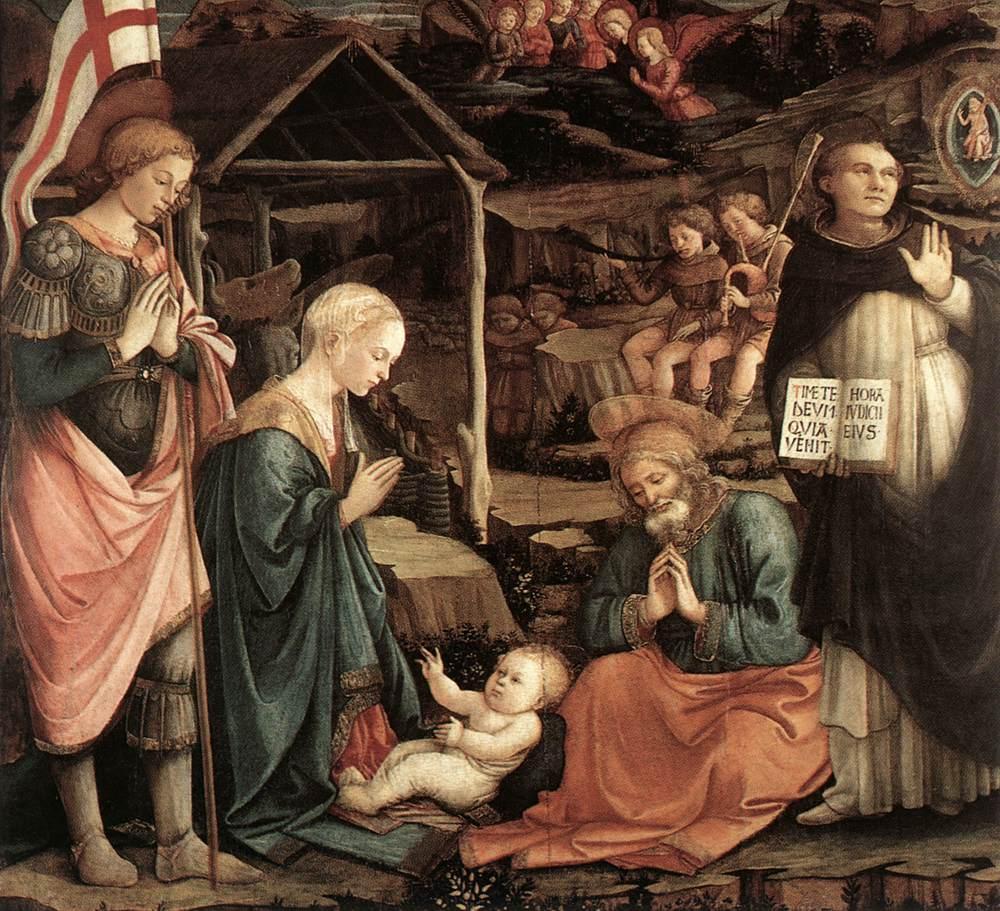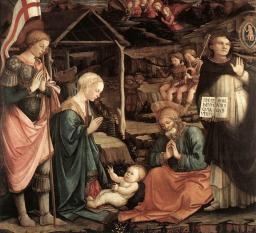“Adoration of the Christ Child” by Filippo Lippi (Erwin Panofsky Method)
The artwork Adoration of the Christ Child, or Nativity with Saint George and Saint Vincent Ferrer, is a painting of the Biblical scene of Jesus’ Nativity which was painted by Filippo Lippi. Art historians believe that it was painted sometime between 1455, the year in which Saint Vincent Ferrer was canonized, and 1466, when Lippi’s stay in Prato ended (Busonero). Its medium is tempera over charcoal sketches on wood panel, and the dimension is 145.5 x 156.5 cm. It was originally painted for the church of Saint Dominic in Prato, Italy. Now, it is located at the Museum of Praetorian Palace in Prato.
This short post, like the previous one in my blog in the Category of Fine Arts, will briefly describe this painting using the iconographical method of Erwin Panofski. Specifically, we will be analyzing the painting on three levels: natural subject matter, conventional subject matter, and intrinsic meaning.
The painting is about the Nativity of an infant lying in the lower middle of the foreground. It has a halo. The lower half of its body is wrapped in cloth. It is looking up and reaching out its hands. Next to the infant, a couple is on their knees and looking and it. The man appears old because he has white beard and hair. The woman on the other side appears younger without any noticeable signs of old age. They both have their palms together in a praying gesture. Each of them has a halo too. Two other male adults flank both sides of the scene. The man on the left wears full armor. He bears a flag pole with a flag of a red cross over a white background. He also has a halo and his hands touching each other in a praying gesture. On the other side, another man with a halo is wearing a typical black-and-white Dominican habit. This man has an open book on his right hand. The books shows the Latin phrase: “Timete Deum quia venit hora iudicii eius”, which translates to “Fear God, for his hour of judgement is coming”. Unlike the other three humans just described, this man directs his look upward. He has his left hand lifted up, pointing toward a mandorla in which another man sits.[1] The man inside the mandorla also has one if his hands pointed upward. He also bears a cross. In the middle ground, we see some animals behind the woman. There are also four young human figures, two of which are on their knees and the other two playing some musical instrument. Above them are six angelic beings with wings and halo. In the background, a mountainous landscape with different kinds of trees can be scene. In the uppermost part of the painting, which means the farthest in terms of perspective in the painting, we can also see clouds and blurry images of mountains afar. This is effective use of atmospheric perspective. Overall, it is a scene about the Nativity of the infant, to which almost everybody in the painting directs their attention.
Judging from the art style and the subject matter, this is the scene of the Nativity of Jesus. Jesus is the infant in the middle, and his human parents, Mary and Joseph are on their knees next to him. Next to Mary, we can see Saint George, who is often presented in art as an armed knight in full armor (Giorgi and Zuffi). As a matter of fact, there are other Saints who are usually depicted with armor, such as Saint Demetrius, Saint Longinus, or Saint Procopius. Still, we can conclude that it is Saint George because of the red cross (Stracke),[2] and of course, because of the artwork’s title itself. On the other side, it is Saint Vincent Ferrer of Valencia. He has a book on his hand with the verse from the book of Apocalypse that is often associated with him in art.[3] Besides, he has ther other hand point toward God, which is also typical of his representation in art. He is known as an angel of Apocalypse because he unceasingly preached about the second coming of Christ, urging people to repent. The man bearing a cross in the mandorla is Jesus Christ Himself, although He, as an infant, is lying there in the foreground. The other humans in the middle ground are either on their knees adoring Jesus the infant, or are playing music in in adoration too. Above their heads, the angels are all looking down at Jesus with their hands crossed or clasped in adoration. All the holy figures, including Jesus as an infant and as a fully grown man in the mandorla, His parents, Saint George, Saint Vincent, and the angels, are represented with a halo.
There are countless numbers of painting on the Nativity of Jesus, but most of them follow the description of the scene by Saint Briget of Sweden. Her vision became the tradition in the represenation of the Nativity (Taylor 59). However, this one is quite unique. Although we do not know for sure how the scene must have looked like just by reading the Gospel, we know very well that some details of the painting are historically inaccurate. Specifically, Saint George and Saint Vincent did not live during the time of Jesus, so they could not have been there. Even the two saints did not live during the same historical time. The choice of these two Saints must have had a specific reason. As for Saint George, it might be because the painter, or the commissioners, had a special devotion to this specific Saint. The choice of Saint Vincent Ferrer is more easily understandable, since he was canonized in 1455, which could have been the year this artwork was painted. The painting itself was commisioned by the Dominicans for the church of Saint Dominic. Besides, Saint Vincent became an important Saint for his constant fight against heresy and in defense of the Church.[4] Moreover, the main message in his homilies reminded that Christ is coming again, which would have been the concern of many faithful believers, especially when they were threatened by the plague.[5] Therefore, put in their historical and social context, the details make sense, and so the painting is significant.
In conclusion, Adoration of the Christ Child by Filippo Lippi is rich in Christian iconography. It has the basic details of a Nativity painting in accordance with traditional iconography. It has its own sui generis details as well. For example, Saint George and Saint Vincent Ferrer are present in this scene. This painting is meaningful to the painter and the church to which it was dedicated. For us modern admirers, this painting enriches the repertoire of Nativity theme in the world of art.
Image

Notes
1. Mandorla is an Italian word that means “almond”.
2. “The Sign of the Cross is a constant both in older versions such as the South English Legendary and in the dragon episode. In of the saint’s entry into Heaven, he is welcomed by Helena, the saint who discovered the True Cross. Most importantly, Voragine reports a story in which the Crusaders at the walls of Jerusalem had a vision of St. George “wearing white armor marked with the red cross.” He encouraged them to scale the walls with him and take the city, which they did.”(Stracker).
3. “Timete Deum quia venit hora iudicii eius” (Apocalypse 14:7). Saint Vincent Ferrer is also known as the Angel of the Apocalypse (Apocalypsis angelus). It is one of his titled, mentioned in the Oratio ad Sanctum Vincentium Ferrerium.
4. The Avignon Papacy.
5. The Black Death.
References
“Biografía De San Vicente Ferrer.” Parroquia San Vicente Ferrer Castellón, 21 Apr. 2019, parroquiasanvicenteferrer.com/biografia-san-vicente-ferrer/.
“Biography of Fra Filippo Lippi.” Fra Filippo Lippi,
Busonero, Stefano. “‘Natività Con San Giorgio e San Vicenzo Ferrer’ Di Filippo Lippi.” Frammentiarte, 2 Feb. 2016,
“Filippo Lippi: Archivio Opere. La Natività Con San Giorgio e San Vicenzo Ferrer Filippo Lippi e Aiuti.” Restauro Filippo Lippi, web.archive.org/web/20100120004700/www.restaurofilippolippi.it/opere/scheda_32.htm.
“George.” Saints in Art, by Rosa Giorgi and Stefano Zuffi, The J. Paul Getty Museum, 2003, pp. 144–147.
“Mandorla.” Britannica, 27 May 1999, Britannica. www.thecanadianencyclopedia.com/en/article/the-tragically-hip-emc. Accessed 24 Jun. 2016.
Stracke, Richard. “Saint George: The Iconography.” Christian Iconography, 2013,
Stracke, Richard. “St. Vincent Ferrer in Art.” Christian Iconography, 2015,
“The Nativity.” How to Read a Church: a Guide to Symbols and Images in Churches and Cathedrals, by Richard Taylor, HiddenSpring, 2005, pp. 58–60.
“Why St. Vincent Ferrer Is Our Patron Saint.” Saint Vincent Ferrer Foundation, 2013,
nghệ thuật
,tôn giáo
,english
,filippo
,lippi
,nghệ thuật
,tôn giáo
,ngoại ngữ
Here's the link to my original post on Wordpress


Nguyễn Duy Thiên
Here's the link to my original post on Wordpress
“Adoration of the Christ Child” by Filippo Lippi (Erwin Panofsky Method) – Vincentius Nguiēn Giaciemēnsis 阮唯天
vincentiusthien.wordpress.com